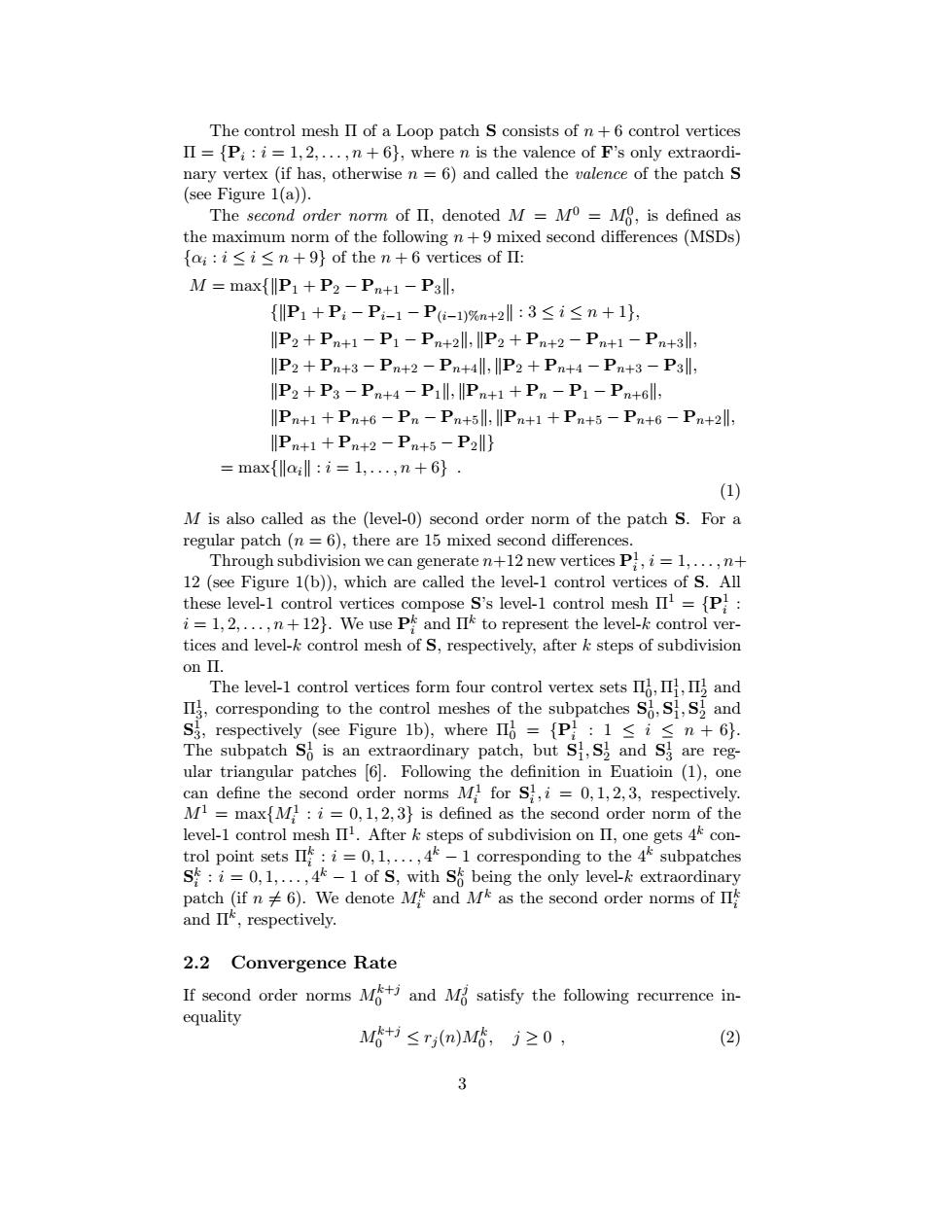正在加载图片...

+12 rtires P!=1. he level-l coutro or of th f subdivis as the 2.2 Convergence Rate edoderoeashMgaadhfsihgyteolowitgeureeete 哈≤r,j≥0 3 The control mesh Π of a Loop patch S consists of n + 6 control vertices Π = {Pi : i = 1, 2, . . . , n + 6}, where n is the valence of F’s only extraordinary vertex (if has, otherwise n = 6) and called the valence of the patch S (see Figure 1(a)). The second order norm of Π, denoted M = M0 = M0 0 , is defined as the maximum norm of the following n + 9 mixed second differences (MSDs) {αi : i ≤ i ≤ n + 9} of the n + 6 vertices of Π: M = max{kP1 + P2 − Pn+1 − P3k, {kP1 + Pi − Pi−1 − P(i−1)%n+2k : 3 ≤ i ≤ n + 1}, kP2 + Pn+1 − P1 − Pn+2k, kP2 + Pn+2 − Pn+1 − Pn+3k, kP2 + Pn+3 − Pn+2 − Pn+4k, kP2 + Pn+4 − Pn+3 − P3k, kP2 + P3 − Pn+4 − P1k, kPn+1 + Pn − P1 − Pn+6k, kPn+1 + Pn+6 − Pn − Pn+5k, kPn+1 + Pn+5 − Pn+6 − Pn+2k, kPn+1 + Pn+2 − Pn+5 − P2k} = max{kαik : i = 1, . . . , n + 6} . (1) M is also called as the (level-0) second order norm of the patch S. For a regular patch (n = 6), there are 15 mixed second differences. Through subdivision we can generate n+12 new vertices P1 i , i = 1, . . . , n+ 12 (see Figure 1(b)), which are called the level-1 control vertices of S. All these level-1 control vertices compose S’s level-1 control mesh Π1 = {P1 i : i = 1, 2, . . . , n + 12}. We use Pk i and Πk to represent the level-k control vertices and level-k control mesh of S, respectively, after k steps of subdivision on Π. The level-1 control vertices form four control vertex sets Π1 0 , Π1 1 , Π1 2 and Π1 3 , corresponding to the control meshes of the subpatches S 1 0 , S 1 1 , S 1 2 and S 1 3 , respectively (see Figure 1b), where Π1 0 = {P1 i : 1 ≤ i ≤ n + 6}. The subpatch S 1 0 is an extraordinary patch, but S 1 1 , S 1 2 and S 1 3 are regular triangular patches [6]. Following the definition in Euatioin (1), one can define the second order norms M1 i for S 1 i , i = 0, 1, 2, 3, respectively. M1 = max{M1 i : i = 0, 1, 2, 3} is defined as the second order norm of the level-1 control mesh Π1 . After k steps of subdivision on Π, one gets 4k control point sets Πk i : i = 0, 1, . . . , 4 k − 1 corresponding to the 4k subpatches S k i : i = 0, 1, . . . , 4 k − 1 of S, with S k 0 being the only level-k extraordinary patch (if n 6= 6). We denote Mk i and Mk as the second order norms of Πk i and Πk , respectively. 2.2 Convergence Rate If second order norms Mk+j 0 and Mj 0 satisfy the following recurrence inequality Mk+j 0 ≤ rj (n)Mk 0 , j ≥ 0 , (2) 3